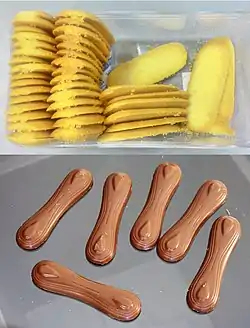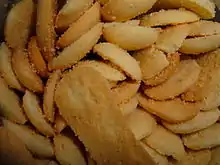Cat tongue
A cat tongue or cat's tongue cookie is a small biscuit or chocolate bar available in a number of European, Asian, and South American countries. They are known locally as "kočičí jazýčky" (Czech), Kattentong (Dutch),[1] "kocie języczki" (Polish), "langue de chat" (French), "Katzenzungen" (German), "lingua di gatto" (Italian), "língua de gato" (Portuguese), "macskanyelv" (Hungarian), "lengua" or "lengua de gato" (Spanish), "limbă de pisică" (Romanian) or "lidah kucing" (Indonesian). They are shaped somewhatlike a cat's tongue (long and flat).[2][3][4] They are sweet and crunchy.[2]
 Cat tongues: biscuits (top), milk chocolate bars (bottom). | |
| Alternative names | Ladyfinger |
|---|---|
| Type | Biscuit or chocolate bar |
| Course | Dessert |
| Place of origin | Austria |


They are produced from egg white, wheat flour, sugar, butter (sometimes) and vanilla [5] or milk chocolate, dark chocolate and white chocolate.[6] They are baked in the oven until cooked.[1] Additional ingredients may include chocolate, citrus, and spices.[2] They are typically prepared with a ganache, cream or jam filling, and sandwiched together.[2][7] They are sometimes dipped in chocolate as part of their preparation.[7] In France, the cookie is often served with sorbet or ice cream.[7]
A cat's tongue mold pan may be used in their preparation, in which cookie dough is placed and then baked.[2] In French, this pan is known as langue-de-chat.[2] This pan is also used in the preparation of ladyfingers and éclairs.[2] The mold is also referred to as a cat's tongue plaque.[8]
In Japan, a "langue de chat" is a square sandwich cookie, made of a layer of white chocolate between two square cookies. Shiroi Koibito is one famous manufacturer, but langues de chat can be found throughout Japan, including 白い針葉樹 in Nagano and まごころづつみ in Hiroshima.
In the Canary Islands, cat's tongue cookies are served with bienmesabe, a dessert dish.[9]
History
Chocolate cat tongues have been in production since before 1900; the Austrian company Küfferle (now owned by Lindt & Sprüngli) has been producing them since 1892. Elsewhere in Europe, companies including Sarotti, Hachez and Halloren make cat tongues. In Brazil, they are manufactured by Zermatt and Kopenhagen. In Chile they are made by Costa under the name "Lengüitas de gato" (little cat tongues). Hungarians widely believe that the Swiss-born Hungarian patissier Emil Gerbeaud invented the delicacy in the late 1880s.[10]
See also
| Wikimedia Commons has media related to Cat tongues (biscuits). |
References
- "KUE LIDAH KUCING". kuenusantara.blogspot.com. Retrieved April 20, 2014.
- The Pastry Chef's Companion - Glenn Rinsky, Laura Halpin Rinsky. p. 53.
- Bonjour, Happiness!: Secrets to Finding Your Joew de Vivre - Jamie Cat Callan. p. 187.
- Cowgirl Chef: Texas Cooking with a French Accent - Ellise Pierce. p. 221.
- "Línguas de Gato".
- Lebensmittel-Lexikon Dr. Oetker, 4. Aufl. 2004, Artikel Katzenzungen.
- Living Gluten and Dairy-Free with French Gourmet Food - Alain Braux. p. 233.
- The well-tooled kitchen - Fred Bridge, Jean F. Tibbetts. p. 168.
- Daft, R. (2008). Menu Del Dia: More Than 100 Classic, Authentic Recipes From Across Spain. Simon & Schuster. p. 140. ISBN 978-1-4165-7961-8.
- About Café Gerbaud. Offbeat Budapest, retrieved on 29 July, 2019